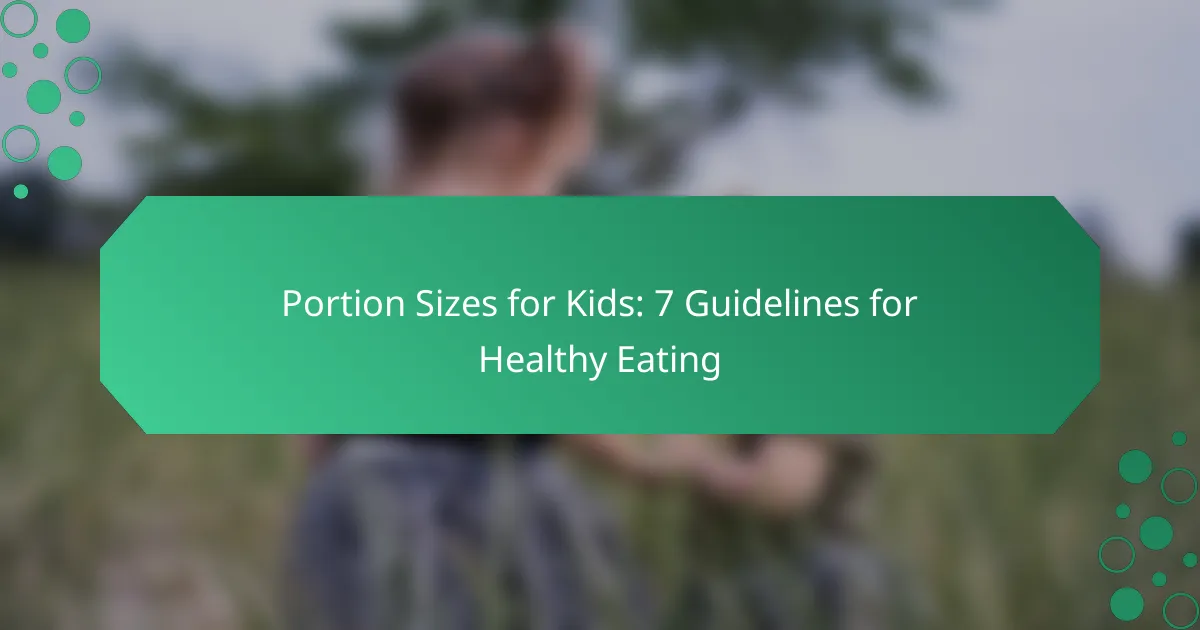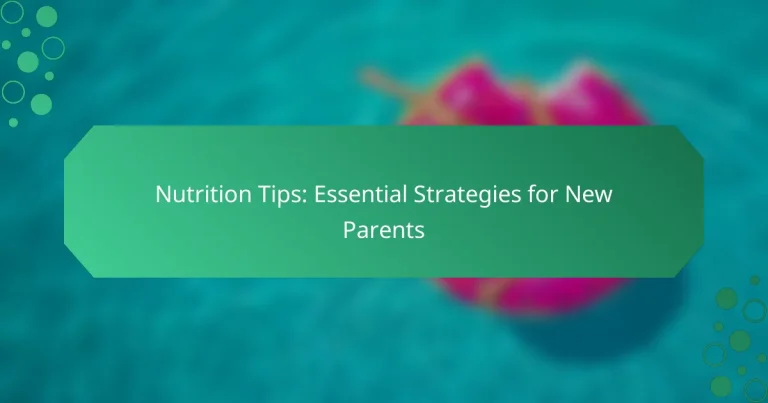Portion Sizes for Kids: 7 Guidelines for Healthy Eating
Portion sizes for kids are crucial for their growth and development, as they vary based on age, activity level, and nutritional requirements. By understanding these guidelines, parents can create balanced meals that promote healthy eating habits and prevent common pitfalls such as overeating. Engaging children in meal selection and preparation further encourages a positive relationship with nutritious foods.

What Are Recommended Portion Sizes for Kids?
Recommended portion sizes for kids vary based on age, activity level, and nutritional needs. Understanding these guidelines helps parents provide balanced meals that support healthy growth and development.
Age-based portion guidelines
Portion sizes should be adjusted according to a child’s age. Generally, younger children require smaller portions, while older kids can handle larger servings. For example, toddlers may need about 1/4 to 1/2 of an adult portion, while children aged 6-12 might eat about 1/2 to 2/3 of an adult serving.
As a rule of thumb, consider serving sizes that are roughly equal to the child’s age in years, multiplied by 1/4 to 1/3 of an adult portion. This approach helps ensure they receive adequate nutrition without overeating.
Food group serving sizes
Each food group has specific serving size recommendations for children. For grains, a serving might be 1/2 cup of cooked pasta or rice. For fruits and vegetables, aim for 1/2 cup of chopped produce or one medium piece of fruit. Protein sources like meat or beans should be around 1 ounce for younger kids and up to 2 ounces for older children.
Understanding these serving sizes can help parents create balanced meals. A simple guideline is to fill half the plate with fruits and vegetables, one-quarter with grains, and one-quarter with protein.
Visual portion size references
Visual cues can help parents gauge appropriate portion sizes without measuring tools. For instance, a serving of meat should be about the size of a child’s palm, while a serving of pasta can be compared to a fist. A serving of cheese is roughly the size of two dice.
Using these visual references can simplify meal preparation and encourage kids to recognize appropriate portion sizes. Avoiding oversized servings can help prevent overeating and promote healthier eating habits.

How Can Parents Encourage Healthy Eating?
Parents can encourage healthy eating by actively promoting nutritious food choices and creating an environment that supports these habits. Engaging children in the process of selecting and preparing meals can foster a positive attitude towards healthy foods.
Modeling healthy eating habits
Children often mimic the behaviors of adults, making it essential for parents to model healthy eating habits. Consistently choosing fruits, vegetables, and whole grains at meals sets a strong example for kids to follow. Sharing meals together can reinforce these choices and make healthy eating a family norm.
Additionally, discussing the benefits of various foods can help children understand why certain choices are better than others. For instance, explaining how carrots can improve eyesight or how whole grains provide energy can make healthy options more appealing.
Involving kids in meal prep
Involving children in meal preparation can increase their interest in healthy eating. Allowing them to help with simple tasks like washing vegetables or measuring ingredients can make them feel invested in the meals they eat. This hands-on experience can also teach them valuable cooking skills.
Consider planning meals together as a family, where kids can suggest their favorite healthy dishes. This collaborative approach not only empowers them but also encourages them to try new foods they may have otherwise avoided.
Creating a positive mealtime environment
A positive mealtime environment can significantly influence children’s attitudes towards food. Establishing regular meal times and minimizing distractions, such as screens, can help kids focus on their food and enjoy the experience. A calm atmosphere promotes better digestion and encourages mindful eating.
Encouraging conversation during meals can also enhance the mealtime experience. Sharing stories or discussing the day can make meals more enjoyable and foster a sense of connection, making children more likely to embrace healthy eating habits.

What Are Common Mistakes in Serving Portions?
Common mistakes in serving portions for kids can lead to overeating or poor nutrition. Understanding these pitfalls can help parents provide balanced meals that align with their children’s needs.
Overestimating portion sizes
Many parents tend to overestimate the portion sizes appropriate for their children, often serving adult-sized meals. A good rule of thumb is to serve about one-quarter of an adult portion for younger children and one-half for older kids.
Using smaller plates can help manage portion sizes effectively. For example, a child’s plate should ideally hold around 1/2 cup of vegetables, 1/4 cup of grains, and 3 ounces of protein.
Ignoring hunger cues
Ignoring hunger cues can lead to forcing children to eat when they are not hungry or not allowing them to eat when they are. It’s essential to teach kids to listen to their bodies, recognizing when they are full or still hungry.
Encouraging children to eat slowly and check in with their hunger levels can help. A simple practice is to ask them, “Are you still hungry?” after a few bites, allowing them to decide whether to continue eating.
Serving unhealthy snacks
Serving unhealthy snacks can undermine healthy eating habits. Instead of chips or sugary treats, opt for fruits, vegetables, or whole-grain options that provide better nutrition.
Creating a snack list can help guide choices. For example, consider offering sliced apples with peanut butter, yogurt with berries, or whole-grain crackers with cheese as healthier alternatives.

How Do Cultural Factors Influence Portion Sizes?
Cultural factors significantly shape portion sizes for children, affecting their eating habits and preferences. These influences can vary widely based on regional practices, traditional meals, and societal norms surrounding food consumption.
Regional dietary practices
Different regions have distinct dietary practices that dictate typical portion sizes for children. For instance, Mediterranean diets often emphasize fruits, vegetables, and whole grains, leading to larger servings of these foods compared to regions where meat is a staple. Understanding these regional variations can help parents provide balanced meals that align with cultural norms.
In many Asian cultures, meals are served family-style, encouraging shared dishes and smaller individual portions. This approach promotes moderation and allows children to sample a variety of foods, which can be beneficial for developing diverse tastes.
Traditional meals and serving sizes
Traditional meals often come with specific serving sizes that reflect cultural significance and historical practices. For example, in many Latin American countries, a typical meal might include a small portion of rice, beans, and meat, which can guide parents in serving appropriate amounts for their children. Understanding these traditional meals can help families maintain cultural ties while promoting healthy eating.
Parents should consider adjusting traditional serving sizes based on children’s age and activity levels. A good rule of thumb is to offer portions that are roughly one-quarter of an adult’s serving size for younger children, gradually increasing as they grow. This approach helps instill healthy eating habits while respecting cultural traditions.

What Tools Can Help Measure Portion Sizes?
Measuring portion sizes accurately is essential for promoting healthy eating habits in children. Various tools can assist parents and caregivers in ensuring that kids receive appropriate amounts of food, helping to prevent overeating and encourage balanced nutrition.
Portion control plates
Portion control plates are designed with specific sections to guide serving sizes for different food groups. These plates often feature visual cues that indicate how much of each food type should be included, such as fruits, vegetables, proteins, and grains.
Using these plates can simplify meal preparation and help children understand healthy eating patterns. For instance, a plate might suggest filling half with vegetables, a quarter with protein, and a quarter with whole grains.
Measuring cups and spoons
Measuring cups and spoons are practical tools for accurately portioning food, especially for recipes or snacks. They allow caregivers to serve precise amounts, which is particularly useful when introducing new foods or controlling calorie intake.
For example, a standard serving of cereal may be around 30 grams, which can be easily measured using a cup. Keeping a set of measuring tools handy can help establish consistent portion sizes for meals and snacks.
Food scales
Food scales provide the most accurate measurement of portion sizes, especially for solid foods. They can help determine the weight of various items, ensuring that servings align with dietary recommendations.
Using a food scale can be particularly beneficial when managing portion sizes for snacks or when preparing meals that require specific quantities. A simple digital scale can help weigh items in grams or ounces, making it easier to adhere to recommended serving sizes.

What Are the Benefits of Proper Portion Sizes?
Proper portion sizes for kids are crucial for promoting healthy eating habits and preventing obesity. By understanding appropriate serving sizes, parents can help children develop a balanced relationship with food, ensuring they receive the necessary nutrients without overeating.
Understanding Portion Sizes
Portion sizes refer to the amount of food served or consumed in one sitting. For children, these sizes should be smaller than adult portions to accommodate their smaller stomachs and energy needs. Familiarizing yourself with standard serving sizes can help in making informed decisions about what to serve.
For example, a serving of fruit for a child might be one medium apple or half a banana, while a serving of grains could be half a cup of cooked rice or pasta. Using visual cues, like a child’s fist for fruits and vegetables, can also aid in estimating appropriate portions.
Guidelines for Healthy Eating
Establishing guidelines for healthy eating can help children learn about balanced diets. The USDA recommends that children’s plates include a variety of food groups, such as fruits, vegetables, grains, protein, and dairy, with an emphasis on whole foods. This balance supports their growth and development.
Encouraging kids to fill half their plates with fruits and vegetables can lead to healthier choices. Additionally, using smaller plates can naturally reduce portion sizes, making it easier for children to manage their intake without feeling deprived.
Common Mistakes to Avoid
One common mistake is serving adult-sized portions to children, which can lead to overeating. Parents should be mindful of their own portion sizes and model appropriate eating behaviors. Another pitfall is allowing children to snack continuously without limits, which can disrupt their natural hunger cues.
To avoid these mistakes, consider setting specific meal and snack times. This structure helps children understand when to expect food and can prevent mindless eating. Additionally, involving kids in meal preparation can teach them about portion sizes and encourage healthier choices.
Practical Tips for Parents
To help children learn about proper portion sizes, parents can implement a few simple strategies. Start by using measuring cups or a food scale to serve meals, which can provide a visual reference for appropriate portions. Gradually, children can learn to estimate portions on their own.
Another effective tip is to encourage children to listen to their bodies. Teach them to recognize hunger and fullness cues, which can help them make better choices about when to eat and how much. Creating a positive mealtime environment, free from distractions, can also support mindful eating habits.



